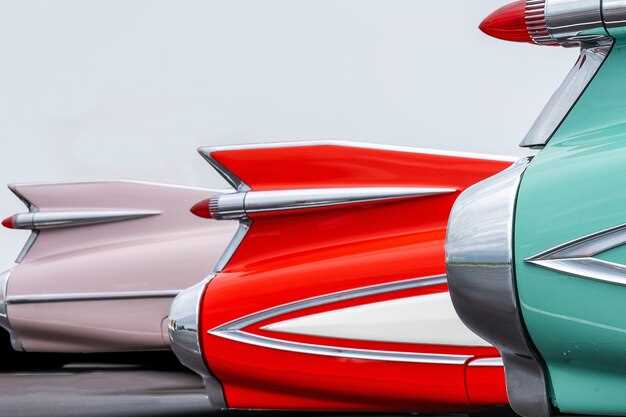Audi History – From Auto Union to Modern Marvel

The history of Audi is a fascinating journey through time, tracing its evolution from the early days of the Auto Union to its state-of-the-art innovations in the modern automotive landscape. This timeline encapsulates the significant milestones that have shaped Audi into a prestigious name synonymous with performance, luxury, and technology.
Founded in 1909 by August Horch, Audi has undergone dramatic transformations and strategic mergers, particularly during its alliance with Auto Union in the 1930s. This collaboration not only united four iconic automotive brands but also laid the groundwork for Audi’s reputation for engineering excellence. The intricate history is peppered with challenges and triumphs that have propelled the brand into the future.
As we explore Audi’s remarkable journey, we will highlight key innovations and groundbreaking technologies that define the brand today. From the legendary Quattro system that revolutionized rally racing to advancements in electric mobility, Audi’s commitment to innovation remains a core aspect of its identity, setting the stage for the next chapter in its illustrious legacy.
The Formation of Auto Union and Its Impact on Audi’s Identity
The establishment of Auto Union in 1932 marked a pivotal moment in the history of Audi, creating a foundation that would reshape its identity and influence its future. Formed through the merger of four manufacturers–Audi, DKW, Horch, and Wanderer–Auto Union aimed to consolidate resources and enhance competitiveness in the automotive market during difficult economic times. This collaboration not only allowed for shared engineering expertise but also led to innovative design and production techniques that would define the brand.
As a part of Auto Union, Audi benefited from the synergy of its parent organization, gaining access to advanced technologies and new markets. The iconic four-ring logo emerged as a powerful symbol of this unity, representing the diverse heritage and collective strength of the four brands. This emblem has since become synonymous with quality and performance, illuminating Audi’s identity as a leader in automotive excellence.
Over the years, the influence of Auto Union on Audi became increasingly evident through its commitment to racing and innovation. The success of the Auto Union Grand Prix cars in the 1930s established a legacy of high-performance engineering that still resonates today. Audi’s focus on combining luxury with sportiness became a hallmark of its brand identity, rooted in the competitive spirit fostered during its time within Auto Union.
In the post-war era, Audi leveraged the legacy of Auto Union to rebuild its brand and capture new audiences. The shift towards modern technology and design, along with a strong emphasis on sustainability, has helped Audi evolve while remaining true to its historical roots. The impact of Auto Union has lasted through decades, as Audi continues to innovate while honoring the legacy of collaboration that defined its formative years.
In conclusion, the formation of Auto Union not only solidified Audi’s position in the automotive industry but also significantly influenced its identity. The marriage of different automotive philosophies and technologies has enabled Audi to emerge as a symbol of luxury and performance, carrying the rich history of its origins into the future.
Key Innovations in Audi Engineering Through the Decades

Audi’s journey from its inception to contemporary advancements showcases a rich history of engineering excellence. This timeline highlights significant innovations that have defined the brand and shaped the automotive industry.
-
1920s – The Birth of Quattro:
Audi introduced the principles of all-wheel drive, setting the stage for the later development of the Quattro system, which revolutionized vehicle handling in various conditions.
-
1930s – Lightweight Construction:
The design of Audi’s Auto Union racing cars utilized lightweight materials, enhancing speed and performance, a philosophy that continues in modern models.
-
1960s – Introduction of the Transverse Engine:
This layout enabled front-wheel drive technology, optimizing interior space while boosting performance in compact models.
-
1980s – Quattro All-Wheel Drive:
The revolutionary Quattro system debuted in the Audi Quattro coupe, providing exceptional traction and stability, particularly in motorsports.
-
1990s – ASF (Audi Space Frame):
Audi introduced the Audi Space Frame construction, utilizing aluminum to create lighter, more fuel-efficient vehicles without compromising safety.
-
2000s – TDI Technology:
Audi’s TDI (Turbocharged Direct Injection) diesel engines became known for their fuel efficiency and performance, setting new standards for diesel technology in luxury vehicles.
-
2010s – Virtual Cockpit:
Innovating digital displays, Audi’s Virtual Cockpit replaces traditional dashboards with a customizable, high-resolution screen, enhancing driver experience and interaction.
-
2020s – Electric Mobility:
The introduction of the Audi e-tron series represents the brand’s commitment to sustainable electric mobility, incorporating advanced battery technology and connectivity features.
Audi continues to push the boundaries of automotive engineering, embedding technological advancements in every new model while honoring its rich heritage.
The Role of Motorsport in Shaping Audi’s Brand Image
Motorsport has been a cornerstone in the evolution of Audi’s brand image, intricately woven into its history since the days of Auto Union. The company’s early involvement in racing laid the groundwork for a reputation centered around performance, innovation, and engineering excellence. Audi’s racing pedigree began to gain global recognition with successes in prestigious events, showcasing groundbreaking technologies that would later influence their commercial vehicles.
The introduction of the quattro all-wheel-drive system in the 1980s marked a pivotal moment for Audi. This technology not only revolutionized rally racing but also solidified Audi’s identity as a pioneer in automotive engineering. The success of the Audi Sport Quattro in the World Rally Championship contributed significantly to the brand’s allure, emphasizing its commitment to performance and setting a benchmark for competitors.
As motorsport evolved into endurance racing, Audi shifted its focus to events like the 24 Hours of Le Mans. The brand’s dominance in this arena, notably with the R8 and R18 models, underscored its engineering prowess and ability to endure extreme conditions. These victories not only enhanced Audi’s image as a continuous innovator but also translated the technologies developed on the track into their production vehicles, further establishing a strong connection between motorsport achievements and consumer expectations.
Moreover, the visibility and excitement generated by Audi’s participation in motorsports have attracted a loyal fanbase, fostering a community that aligns with the brand’s values of progression and performance. The marketing strategies employed during this period have successfully integrated the thrill of racing into Audi’s branding, effectively translating the motorsport spirit into everyday driving experiences for consumers.
In summary, the interplay between Audi’s motorsport involvement and its brand image has been instrumental in shaping its identity as a leader in performance and technology. The legacies established on racetracks continue to resonate with enthusiasts and customers alike, ensuring that Audi remains synonymous with innovation and dynamic engineering in its ongoing history.
Strategic Mergers and Acquisitions: Audi’s Growth Story

Audi’s history is marked by strategic decisions that have shaped its trajectory in the automotive industry. The brand’s growth has been significantly influenced by various mergers and acquisitions, which have enabled it to expand its technological capabilities and market reach.
One of the critical phases in Audi’s history occurred in 1965 when it merged with the Auto Union. This merger brought together four brands–Audi, DKW, Horch, and Wanderer–under one umbrella, allowing for resource sharing and technological advancements. This consolidation not only revitalized the Audi brand but also set the stage for future innovations in design and engineering.
In the 1980s, Audi became known for its pioneering work in automotive technology, particularly with the introduction of the Quattro all-wheel-drive system. This innovation was made possible through the support gained from the Auto Union merger, which streamlined resources and fostered a culture of collaboration within the company.
Further growth was achieved in 1998 when Audi became a part of the Volkswagen Group. This acquisition provided Audi with access to a broader platform for development and production, allowing the brand to upscale its research and development capabilities. The merger facilitated cross-brand technology sharing, enhancing Audi’s offerings in terms of performance, safety, and sustainability.
Today, Audi continues to leverage successful mergers and acquisitions to maintain its competitive edge. Collaborations with technology firms aim to integrate advancements in artificial intelligence and electric vehicle construction, ensuring that Audi remains at the forefront of innovation in the automotive market.
| Year | Event | Impact on Audi |
|---|---|---|
| 1965 | Merger with Auto Union | Resource sharing and brand revitalization |
| 1980s | Introduction of Quattro technology | Pioneering automotive technology and brand recognition |
| 1998 | Acquisition by Volkswagen Group | Enhanced R&D capabilities and access to broader markets |
| 2020s | Ongoing collaborations with tech firms | Integration of AI and EV technology for future growth |
Electrification and Sustainability Initiatives in Audi’s Modern Lineup
Audi’s commitment to electrification reflects a significant shift in its history, moving from traditional internal combustion engines to a future driven by electric mobility. The company has integrated sustainability into its core strategy, showcasing this transition through its expanding lineup of electric vehicles.
The Audi e-tron, the brand’s first all-electric SUV, marked a pivotal point in this journey. With a focus on reducing carbon emissions, Audi employs advanced technologies for battery performance and charging efficiency. The e-tron exemplifies how the brand merges luxury with sustainable energy solutions.
In addition to electric vehicles, Audi is investing heavily in sustainable manufacturing processes. Initiatives include utilizing renewable energy sources in production facilities and embracing circular economy principles. By closing the loop on resource consumption, the brand aims to minimize its environmental footprint.
The launch of the Q4 e-tron further demonstrates Audi’s strategy to cater to diverse customer needs without compromising on sustainability. This compact electric SUV combines modern design and innovative technology while promoting eco-friendly driving experiences.
Audi’s efforts extend beyond the vehicles themselves; the company is also focused on promoting sustainable practices within its supply chain. Collaborations with suppliers committed to ethical sourcing and reduced emissions reinforce Audi’s holistic approach to sustainability.
In summary, the electrification of Audi’s lineup signifies a vital era in the brand’s history, marking its dedication to innovation and environmental stewardship. With forward-thinking initiatives, Audi is not only shaping the future of mobility but also setting an industry standard for sustainability.
Future Directions: Audi’s Vision for Mobility and Technology
Audi is poised to redefine the landscape of mobility and technology, guided by a strategic timeline that emphasizes innovation and sustainability. The brand’s vision encompasses several key areas:
- Electrification: Audi aims to expand its electric vehicle lineup significantly by 2025, with plans to launch multiple models under the e-tron series. This transition to electrification reflects Audi’s commitment to reducing carbon emissions and promoting environmental responsibility.
- Autonomous Driving: Audi’s research into autonomous vehicle technology leads the industry. The company has set ambitious goals for Level 4 automation, ensuring safety and convenience for drivers and passengers.
- Connectivity: Integration of advanced connectivity features in vehicles is a priority. Audi envisions a seamless exchange of data between cars, infrastructure, and users, enhancing the driving experience while optimizing traffic management.
- Digital Transformation: Audi is investing in digital services to complement its vehicles. Innovations like the myAudi app and over-the-air updates represent a shift towards a more user-centered approach in automotive technology.
- Sustainable Manufacturing: Audi’s commitment to sustainability extends to its production processes. The company is working towards creating carbon-neutral plants and utilizing renewable energy sources to minimize its environmental footprint.
The future timeline for Audi demonstrates a clear roadmap for achieving these goals. By focusing on innovation and sustainability, Audi is not only leading the way in automotive technology but also shaping the future of mobility as a whole. With its rich history and forward-thinking ethos, Audi continues to be a pioneer in the automotive industry.



